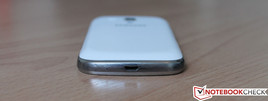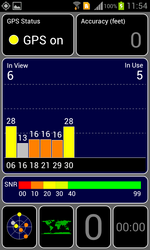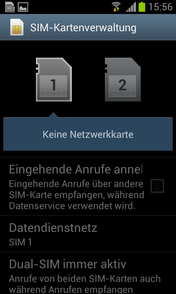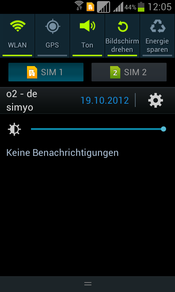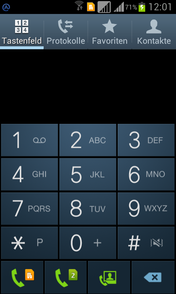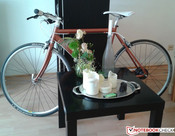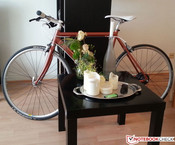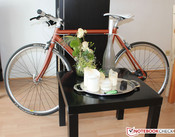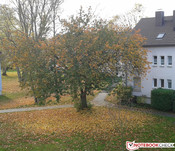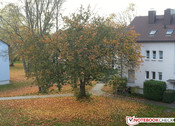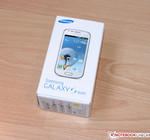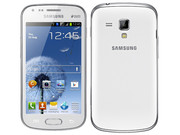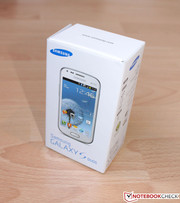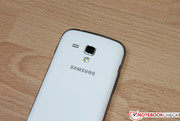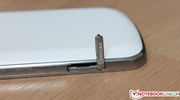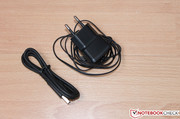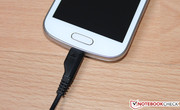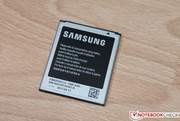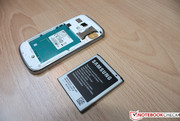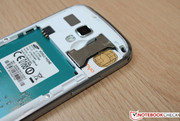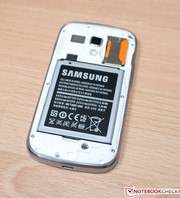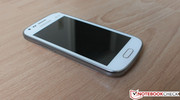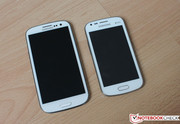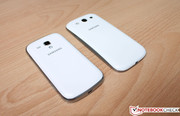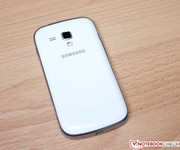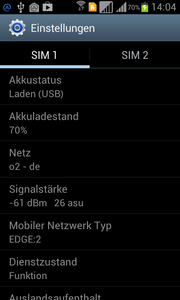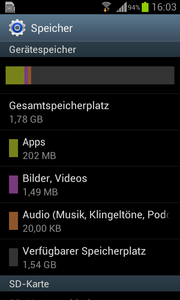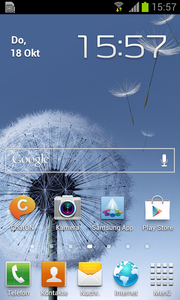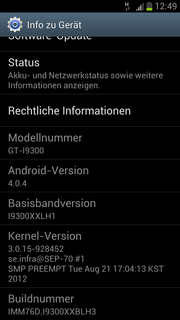Review Samsung Galaxy S DUOS GT-S7562 Smartphone

Everyone probably knows this problem: you do not want to leave your cellphone at home when travelling to another country but do not want to pay steep roaming prices. Dual SIM smartphones have a clever solution for such dilemmas. The device can accommodate two SIM cards and dial into the respective network at the same time. So you can, for example, browse the internet with the SIM card of a foreign provider when you are abroad and do not have to inconveniently exchange the cards. This is only one possible scenario. Dual SIM devices are also often used in cases where an employer supplies a mobile phone contract and the employee wants to use a private contract next to it.
An increasing number of smartphones that feature dual SIM technology are found on the market for the reasons mentioned above. However, it is striking that none of the available devices are high-end smartphones, like for example Samsung's Galaxy S3. Our review reveals how our test device, Samsung's Galaxy DUOS, fares with its hardware and particularly just how viable the dual SIM feature is in everyday use.
Case
Samsung also sticks to its line with this device and does not use metal on the casing's exterior, unlike frequently seen in competitors (e.g. HTC's One X / HTC's One S). The display bezel and the entire casing are made of plastic, which naturally has an effect on the weight. The total weight, including the battery, is 120 grams. That is 13 grams less than Samsung's Galaxy S3 flagship product. The charger weighs 36 grams. A plus point that pleases us is the matte-white battery lid, because fingerprints and micro-scratches virtually remain invisible. This regrettably cannot be said about the screen. As usual for this device category, a glare-type screen is installed, so a micro-fiber cloth should always be at hand for wiping off annoying fingerprints. Owing to the marginally protruding display bezel, the Galaxy S DUOS does not completely rest on the display. The silver-colored plastic bezel's surface texture strongly resembles brushed aluminum. Since Samsung is adept at using poly-carbonates, we do not discover any flaws in terms of stiffness or workmanship on this smartphone.
The casing's rear also defies selective pressure. All gaps are even and the device's workmanship is absolutely meticulous. Both the volume rocker's and power button's pressure point is good as usual and the home button's pressure point feels even better. The device looks a lot like the Galaxy S3 due to its design and the buttons' positioning. However, we see clear differences in the dimensions. The Galaxy S DUOS is not as slim with 10.5 mm as the Galaxy S2 (8.5 mm) or S3 (8.6 mm). Also, it is not as wide (63 mm) or as high (122 mm). It is comfortable to hold and is easy to use with one hand due to the low width and height. The smartphone is currently available in "pure white".
Connectivity
As described above, the Galaxy S3 and Galaxy S DUOS look alike, apart from their size. This also becomes evident looking at the installed buttons. The power button is inserted on the case's right edge. The volume rocker is found in the upper third on the opposite side's edge. There is a touch button for navigating or opening other menus in the system on the physical home button's left.
The micro USB 2.0 port on the smartphone's lower edge can be used for recharging the device or connecting it to a PC. It was detected as a storage device right away. The 3.5 mm stereo jack is installed at the top. The micro SD card reader supports cards with up to 32 GB. It is not found underneath the battery lid in this model, but rather on the casing's right. A small flap protects the port from grime. An internal memory of just 1.78 GB is available ex-factory, which makes an external memory card almost inevitable. Regrettably, Samsung does not offer a Galaxy S DUOS model with a larger device memory.
Software
Samsung delivers its dual SIM smartphone with Android 4.0.4 (Ice Cream Sandwich/ICS) and its own Launcher Touchwiz 4.0. As usual for Samsung's smartphones, we also find preinstalled software such as Messenger ChatON, Game Hub and Samsung apps. We do not have to look long for bloatware either. The apps Delivery Hero, myTaxi, HRS Hotels, a shopping app and the like are preinstalled.
Communication & GPS
The Galaxy S DUOS can compete with its bigger relatives and most definitely with its direct contenders, such as Sony's Xperia tipo dual, in terms of communication modules. The integrated Wi-Fi module transmits via the 802.11 b/g/n standard. A fast mobile internet connection is a must for such a smartphone. The HSDPA unit receives data with a maximum transfer rate of 7.2 Mbit/s. A feature of the test device is both wireless modules that provide a quad-band+W-CDMA (1900/1800/900/850 MHz). This enables dual SIM telephony, but more about that in the part "Dual SIM Function".
Bluetooth 3.0 and A-GPS (assisted GPS) can also be found in the smartphone's connectivity. The GPS receiver detects the signal immediately; even indoors in the area of a window.
Dual SIM Function
A special highlight of this device is doubtlessly the option to use two SIM cards at the same time. It is possible to use the advantages of different contracts or pre-paid cards. For example, it is possible to take advantage of a particularly favorable mobile data service contract for abroad and still use the standard rate for making calls, while being online at a very reasonable price when abroad. There are many possibilities and can be customized without having to swap the SIM card every time or carry around several phones.
The software implementation is at least just as interesting as the feature itself. It is already clear when entering the PIN that this is not a normal phone. The PINs of both SIM cards have to be entered directly behind each other - and then the next feature is noticed: there are two reception indicators in the status bar. That means that both SIM cards are connected to their respective network. Consequently, it is possible to be available under both telephone numbers. Vice versa, it is possible to choose which number is to be used for calling while dialing the contact's telephone number. The status bar also indicates which one of the two cards is currently the standard card for sending SMS or accessing mobile internet. This selection has been implemented in the vertical slider so that it is possible to switch between cards quickly. The dual SIM feature works very well in everyday use and provides the user with many advantages. We do not really understand why there are still so few devices with this feature on the market and why it is completely omitted in high-end smartphones.
Cameras & Multimedia
Samsung installs two camera modules in the device for occasional snapshots and internet calls. The primary camera features a resolution of 5 megapixels (2592x1944 pixels) and the software offers a 4x digital zoom. The secondary camera on the front is not as good and only has a resolution of 640x480 pixels, i.e. it supplies 0.3 megapixels. However, that is still sufficient for applications like Skype, although it does not live up to Samsung's technical standards at all. Unfortunately, videos can only be made in a resolution of 640x480 pixels with both cameras. The primary camera also features a precise autofocus and the LED flash reduces image noise in poor ambient light.
We noticed a bluish cast on indoor pictures in our practical test. Also, the pictures are paler and less color intensive than from Samsung's Galaxy S3 or our Canon EOS 600D reference camera. The bluish cast is not as severe for outdoor pictures but the lack of color intensity is still clearly noticed. Motifs with a lot of details are slightly unfocused, also because of the low resolution of 5 megapixels.
Accessories
Samsung follows it current trend for the smartphone's accessories. In keeping with the motto "less is more", we only find the charging cord, an additional data cable for connecting to a computer and the mandatory quick start guide. No matter how often we search in the box, we cannot find an in-ear headset like the one that is included with Samsung's Galaxy S3. The included lithium ion battery has a capacity of 1500 mAh and is just as big as the one for the Galaxy S3 in terms of width and length.
Warranty
Samsung includes a 24 month warranty on material and manufacturing errors and 6 months on the included accessories for this product.
Input Devices & Controls
Samsung installs a capacitive touchscreen in the Galaxy S DUOS as known from all current smartphones. The screen responds accurately and very precisely to inputs. Multi-touch gestures, such as pinch-to-zoom or tap-to-zoom, are implemented precisely and are as fast as expected. The preinstalled touch keyboard can of course be swapped if desired. The example on the left shows Samsung's default keyboard and the right shows a keyboard app from Google's Play Store (SwiftKey 3). Optional software usually has the advantage that a lot more settings are possible and both the looks and haptics can be customized.
The combination of the physical home button and the bordering touch keys has to be mentioned as an important input device as they make navigating through the Android operating system possible. Samsung also sticks to its line here and insists on the well-tried hardware button. Other manufacturers only install touch buttons for navigating in the operating system. The user can also wake up the smartphone from standby by pressing the home button. We deem this a very handy additional feature.
Display
We already know the Super AMOLED+ screen that exhibits very saturated colors from Samsung's best-selling Galaxy S2 and Galaxy S3. Our test device regrettably does not feature this technology. Instead, a 4-inch TFT screen does its job underneath the touch-surface. This correlates to a screen size of 10.16 cm. The Galaxy S2 sports a 4.3-inch screen and the Galaxy S3 has a 4.8-inch display. The display resolution of 480x800 pixels results in a pixel density of 233 ppi in the device at hand. The Galaxy S2 has a lower pixel density of 217 ppi. The Galaxy S DUOS does not feature automatic brightness control. The brightness sensors are installed at the touchscreen's upper edge in many current smartphones and modify the screen's brightness according to light intensity. To compensate for the lack of this feature to an extent, Samsung implements the possibility to quickly adapt the presently required brightness via the vertical slider menu. That is faster than via the settings.
Although we do not have such a brilliant color reproduction as with the PenTile Matrix screen in the Galaxy S3 or the IPS screen in HTC's One X - which is particularly noticed when looking at pictures - we are nevertheless satisfied with the TFT screen's overall reproduction and can work with it pleasantly.
| |||||||||||||||||||||||||
Brightness Distribution: 92 %
Center on Battery: 342 cd/m²
Contrast: 518:1 (Black: 0.66 cd/m²)
The screen brightness measurement using the Gossen Mavo Monitor supplies information about the factual brightness and black value. We measured a maximum brightness of 342 cd/m2 in the screen's center. This rate decreased to 315 cd/m2 at the edges. In total, this results in an average brightness of 326.7 cd/m2. Thus, the screen is approximately 30 cd/m2 brighter than HTC's One S. The illumination of 92% is an acceptable rate for the TFT screen. The black value cannot technologically reach the exceptional rates displayed by a Super AMOLED+ or IPS screen. Here, we ascertained a rate of 0.66 cd/m2 which results in a contrast of 518:1.
Screen content can still be read well outdoors in little sunlight or cloudy conditions using maximum brightness. However, it is not only noticed that the brightness is insufficient in very bright sunlight but that the glare-type screen is also extremely reflective. The problem with the reflective screen can be prevented to the greatest extent by using a matte screen protector. Such protectors make the screen glare-free and provide a higher protection against scratches at the same time.
Regrettably, an IPS or Super AMOLED+ screen like we know from high-end devices is not installed here. However, the TFT touchscreen reproduces the colors very well and also has good viewing angle stability. The content is well-legible from virtually all angles.
Performance
Not only the screen indicates that the Galaxy S DUOS is not a high-end device. Samsung normally uses proprietary chip sets in its flagships. An Exynos 4 quad system-on-a-chip (SoC) powers the Galaxy S3. Our test device sports a Qualcomm Snapdragon MSM7227A with an ARM Cortex A5 single-core processor that runs with a clock speed of 1 GHz. It also sports a 512 MB working memory and a 1.78 GB internal memory. The Adreno 200 (Enhanced) GPU takes care of graphic applications.
We sent the test device through various benchmarks in order to compare it with other smartphones. The test results reflect the performance of the installed hardware. The Galaxy S DUOS is clearly inferior to its higher-end contenders. Even Samsung's 17 month old Google Nexus, which features the same GPU, processor clock rate and 512 MB of working memory, is superior in most benchmarks. In synthetic benchmarks, such as Basemark ES 2.0, the performance difference between the Galaxy S DUOS and Galaxy S3 is a full 704%. The difference is no longer as extreme in browser-based benchmarks, although it is still evident. Looking at the write / read speeds in AndroBench clearly show that it is at best a midrange model.
| Google V8 Ver. 7 - Google V8 Ver. 7 Score (sort by value) | |
| Samsung Galaxy S DUOS GT-S7562 | |
| HTC One S | |
| HTC One X | |
| Samsung Galaxy S3 | |
| Samsung Google Nexus S I9023 | |
| Browsermark 1.0 - --- (sort by value) | |
| Samsung Galaxy S DUOS GT-S7562 | |
| HTC One S | |
| HTC One X | |
| Samsung Galaxy S3 | |
| Samsung Google Nexus S I9023 | |
| Linpack Android / IOS - Multi Thread (sort by value) | |
| Samsung Galaxy S DUOS GT-S7562 | |
| HTC One S | |
| HTC One X | |
| Samsung Galaxy S3 | |
| Samsung Google Nexus S I9023 | |
| NenaMark2 - --- (sort by value) | |
| Samsung Galaxy S DUOS GT-S7562 | |
| HTC One S | |
| HTC One X | |
| Samsung Galaxy S3 | |
| Samsung Google Nexus S I9023 | |
| Basemark ES 2.0 - Taiji Free (sort by value) | |
| Samsung Galaxy S DUOS GT-S7562 | |
| HTC One S | |
| HTC One X | |
| Samsung Galaxy S3 | |
| Samsung Google Nexus S I9023 | |
| GLBenchmark 2.5 - 1920x1080 Egypt HD Offscreen Fixed Time (sort by value) | |
| Samsung Galaxy S3 | |
| AndroBench 3-5 | |
| Random Read 4KB (sort by value) | |
| Samsung Galaxy S DUOS GT-S7562 | |
| Samsung Galaxy S3 | |
| Random Write 4KB (sort by value) | |
| Samsung Galaxy S DUOS GT-S7562 | |
| Samsung Galaxy S3 | |
We used three trailers to ascertain whether the smartphone has enough resources to play high definition videos smoothly. The trailer from "Transformers 3 - Revenge of the Fallen" was played in both Full HD (1080p) and HD (720p). Only the soundtrack and not the video track was transmitted in both cases. The test was performed using three different players: the preinstalled video player, QuickPic Video Player and MXPlayer, to exclude a software-based app problem. We excluded an error in the video file using the trailer "James Bond - Skyfall" (also in Full HD) and came to the same conclusion: HD movies cannot be rendered.
Up-to-date games, e.g. all versions of Angry Birds, ran without problems on the Galaxy S DUO S. The installed SoC is also strong enough to smoothly render GTA III, a well-known 3D game, in low details.
Much more focus is placed on the phone function in this smartphone than in other devices, because of the two SIM cards. The speech quality is consistently good, but we noticed that the contact's voice sounds a bit muffled in diverse calls. The installed speaker's maximum volume is sufficient in both the hands-free mode as well in the "normal" mode. However, it starts to distort and sound tinny at 80% of maximum volume. The contact can be understood well even in surroundings with stronger background noise. The contact did not have any complaints about the speech quality.
Emissions
Temperature
The Galaxy S DUOS does not sport an active fan and is consequently only cooled passively. This has a positive effect on the system noise. Since the hardware does not run at extremely high clock rates, the single components do not get exceedingly hot. The area around the power inlet heated up to 43.8 °C during load. Our guess is that the SoC is located here. The temperatures of all other areas on the front and back ranged from 33.1 to 36.6 °C. The temperatures of every section were lower by 2 to 4 °C and even a whole 12.6 °C lower at the power inlet in idle mode. This means using the smartphone will unlikely ever be unpleasant. The CPU and GPU load will not permanently be as high as in our stress test even when playing performance-hungry games. Consequently, the temperatures will be lower than in our load scenario.
(±) The maximum temperature on the upper side is 43.8 °C / 111 F, compared to the average of 35.2 °C / 95 F, ranging from 21.9 to 247 °C for the class Smartphone.
(+) The bottom heats up to a maximum of 36.6 °C / 98 F, compared to the average of 34 °C / 93 F
(+) In idle usage, the average temperature for the upper side is 31.8 °C / 89 F, compared to the device average of 32.9 °C / 91 F.
Speakers
Samsung installs a speaker to the primary camera's immediate left. The maximum volume is definitely sufficient, but the speaker sounds tinny and starts to distort slightly at approximately 75% of the maximum volume. Of course, the playback is not at all bass-heavy. We would recommend connecting external speakers, even big, active ones, or headphones via the 3.5 mm jack on the casing's top despite the acceptable results. Regrettably nothing of the kind is included.
Battery Life
Power Consumption
The ascertained power consumption allows initial conclusions about the battery consumption. The consumption measurement in both off and standby showed that 0.6 W and 0.9 W respectively are continuously needed. For comparison, the Galaxy S3 only consumed 0.25 W in a turned off state, i.e. less than half the amount in the same time. Between 0.7 and 1.8 watts are consumed in idle mode. Our test device proves to be more energy-efficient than the Galaxy S3 (3.3 - 3.4 watts) in load scenarios with rates between 2.3 and 2.7 watts. We mentioned the omitted automatic brightness control in "Display". The lack of this function has an indirect impact on the power consumption and ultimately on battery life. The user will not permanently modify the brightness and this could inevitably lead to a higher consumption.
| Off / Standby | |
| Idle | |
| Load |
|
Key:
min: | |
Battery Runtime
We used four scenarios to test the battery runtime. The battery is completely drained and the device shuts down within 4 hours and 51 minutes in the full load scenario. This test was performed using the app "Stability Test", which simulates a maximum processor load. It took 3 hours and 1 minute to completely recharge the battery via the mains. Recharging the smartphone via a laptop USB port could take longer. The test using a screen brightness of approx. 150 cd/m2 reflects the most realistic usage pattern. Here, the Wi-Fi module is enabled and a script simulates simple browsing behavior. The full battery lasted for 9 hours and 25 minutes. We ascertain the maximum battery runtime with disabled wireless modules and permanently active screen in the lowest brightness. The Galaxy S DUOS ran for 12 hours and 36 minutes in this scenario. On its product site, Samsung specifies a battery runtime of 8.3 hours when making calls via a 3G network.
Verdict
Samsung's Galaxy S DUOS is a rock-solid, well-built smartphone featuring the exciting dual SIM technology. When looking for dual SIM smartphones, we notice that the market is not very big and that high-performance alternatives are not available. The Galaxy S DUOS is the leader of the dual SIM smartphone sector with its installed hardware. Although the manufacturer's basic approach is going in the right direction, a clear plus in performance would have greatly improved the overall rating. The working memory and the SoC cannot render HD videos and the installed cameras lag far behind the ones in Samsung's Galaxy S3. However, high-end hardware cannot be expected for a current street price of 250 Euros (~$318). The Galaxy S DUOS is aimed at users who need more than one SIM card in everyday life and do not have the highest requirements on performance in a smartphone.





